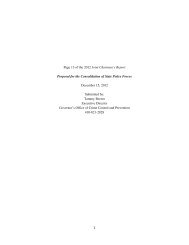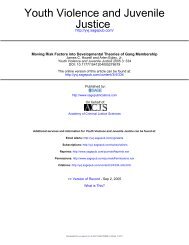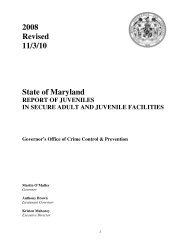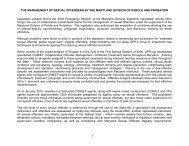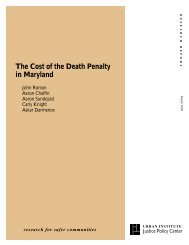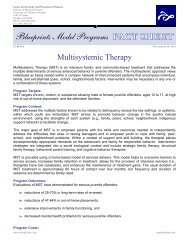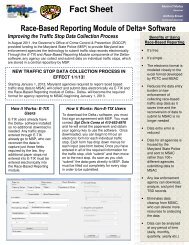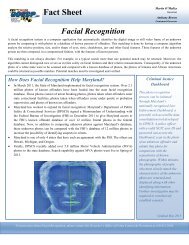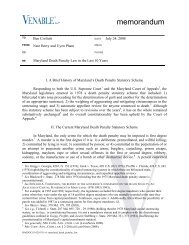Targeted Outreach - Governor's Office of Crime Control & Prevention ...
Targeted Outreach - Governor's Office of Crime Control & Prevention ...
Targeted Outreach - Governor's Office of Crime Control & Prevention ...
You also want an ePaper? Increase the reach of your titles
YUMPU automatically turns print PDFs into web optimized ePapers that Google loves.
Summary and Conclusion 43<br />
outside agencies were sometimes slow to develop,<br />
once they developed, they <strong>of</strong>fered multiple benefits.<br />
These relationships allowed the Clubs to receive<br />
referrals and also provided settings for direct outreach<br />
in recruiting youth.<br />
The documentation process, although time consuming,<br />
led to increased contact with the youth and<br />
knowledge about how they were doing in the different<br />
domains <strong>of</strong> their lives. This level <strong>of</strong> contact with<br />
the youth may be a factor in why youth in GPTTO<br />
and GITTO reported such high levels <strong>of</strong> adult support<br />
from Club staff. Clubs that maintained documentation<br />
found that they were in a good position to<br />
show the credibility <strong>of</strong> their project and work with<br />
youth, going beyond just being a recreation facility.<br />
At What Cost?<br />
Costs to society associated with gang suppression<br />
include police time, graffiti removal, court fees and<br />
protective services, plus the non-monetary negative<br />
<strong>of</strong> the fear <strong>of</strong> being out on the streets and the loss <strong>of</strong><br />
lives from gang-aggressive acts and interactions. A<br />
1998 study estimated the total costs to society <strong>of</strong><br />
allowing one youth to leave high school for a life <strong>of</strong><br />
crime and drug abuse to be somewhere between $1.7<br />
and $2.3 million (Cohen, 1998). For the youth’s four<br />
years as a juvenile, the study estimated the criminal<br />
justice costs at $21,000 to $84,000. In contrast, investment<br />
in deterring a youth from or reducing youth’s<br />
involvement in gangs can save a substantial amount<br />
<strong>of</strong> taxpayer money and community stress, both in the<br />
short and long term.<br />
What would be the cost <strong>of</strong> supporting more Clubs to<br />
implement GPTTO or GITTO initiatives at their facilities?<br />
This evaluation did not include a cost study, so<br />
we cannot precisely document the annual cost <strong>of</strong> supporting<br />
Club services for additional target youth.<br />
However, we did ask Clubs to provide their budgets<br />
for October 1997 to September 1998 and thus have<br />
some information on their direct expenses for that<br />
year. Building their programs from an initial $4,000<br />
in seed money for prevention and $15,000 for intervention<br />
received from OJJDP through BGCA, 19 prevention<br />
programs raised additional funds ranging<br />
from $3,000 to $46,000, and intervention programs<br />
raised from $22,000 to more than $1 million to cover<br />
the costs <strong>of</strong> one year <strong>of</strong> implementation. As depicted<br />
in Table 13, taking into account the number <strong>of</strong> youth<br />
served, the average cost <strong>of</strong> adding on GPTTO/GITTO<br />
for one GPTTO target youth was $340, for GITTO<br />
youth, $1,889. However, half the GPTTO Clubs spent<br />
less than $282 per youth in direct funding.<br />
It is important to keep in mind that these are direct<br />
costs and do not include resources spent on Club operating<br />
expenses or management, facility upkeep or maintenance,<br />
or the in-kind contributions <strong>of</strong> Club staff and collaborating<br />
agencies. Thus, $340 for prevention and $1,889 for<br />
intervention are not the total costs but should be<br />
considered the incremental costs for adding services to<br />
new youth. The relatively low figures mark the<br />
advantage and efficiency <strong>of</strong> using established agencies<br />
and enhancing their services to reach these<br />
harder-to-reach youth.<br />
The main costs for both GPTTO and GITTO were<br />
for staff salaries (generally one half or more <strong>of</strong> the<br />
expenses). Staff time taken up by GPTTO or GITTO<br />
responsibilities was devoted to outreach, to spending<br />
time in settings outside the Club to build partnerships<br />
and referral relationships, and to completing<br />
the paperwork for the program. And, although the<br />
outreach and recruitment efforts, networking time<br />
and case management approach utilized by the<br />
Clubs implementing GPTTO and GITTO can be<br />
costly, these costs can be contained by the volume <strong>of</strong><br />
youth already served by the Clubs and the facilities<br />
already in place.<br />
Even if the full cost <strong>of</strong> implementing GPTTO or<br />
GITTO were twice as large as these incremental costs,<br />
they are minimal in relation to the amount society<br />
would otherwise spend on gang suppression and<br />
incarceration for these youth. The cost is also relatively<br />
low, considering the challenges associated with<br />
reaching and serving this high-risk population <strong>of</strong><br />
youth, the level <strong>of</strong> the youth’s engagement and the<br />
alternative cost to society <strong>of</strong> juvenile gang involvement,<br />
crime and delinquency. In sum, the cost <strong>of</strong> the<br />
initiative appears worth the benefits accrued to youth<br />
and the potential for savings over the long term.<br />
Final Thoughts<br />
Although this evaluation was launched with specific<br />
questions pertaining to GPTTO’s and GITTO’s effectiveness<br />
in recruiting, serving and helping high-risk



